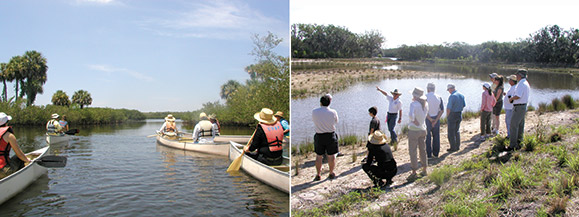 Restoration project areas.
Restoration project areas.
Recently, District Governing and Basin Board members and staff got an up-close look at restoration projects and toured major components that are part of the Lower Hillsborough River Recovery Strategy.
Terra Ceia and Cockroach Bay
One tour viewed restoration projects from infancy to maturity at the Terra Ceia and Cockroach Bay preserves.
This tour was designed to give Board members and staff a better understanding of the type, breadth and depth of the Tampa Bay restoration projects, according to Brandt Henningsen, District chief environmental scientist with the Surface Water Improvement and Management Program.
“We looked at a cross section of different phases and ages of restoration,” said Henningsen. “We saw restored wetland systems as old as 14 years and as young as two years.”
Members toured the new Terra Ceia project and then traveled up to the mature restoration project at Cockroach Bay. Some took an afternoon canoe trip through a restored tidal lagoon; then, for comparison, they traveled into a natural tidal lagoon.
“The District has completed 78 restoration projects throughout the Tampa Bay area since 1989,” said Henningsen. “It’s important for Board members to see these projects in person so they have some additional perspective on the projects they’re discussing.”
The experience was a good one, according to Lou Kavouras, deputy executive director for District Outreach, Planning, Board Services & Ombudsman.
“It’s such a success story down there,” said Kavouras. “The Board members saw what a project looks like at the beginning in Terra Ceia, and they saw areas in Cockroach Bay that we have finished. The tour helped them use what they saw at Cockroach Bay to envision that kind of final result for Terra Ceia.”
Lower Hillsborough River Recovery Strategy
District Board members and staff also toured areas of Tampa to see some of the building blocks of the Lower Hillsborough River Recovery Strategy.
The tour began at the Hillsborough River Dam at Rowlett Park where additional water will be directed to help meet the minimum flow for the river. The tour visited water sources at Sulphur Springs, Blue Sink and Morris Bridge Sink and finished at the Harney Canal.
“There are challenges in urban projects that we don’t have at some of our restoration sites such as Terra Ceia and Cockroach Bay,” said Maya Burke, District staff planner.
Burke said the tour gave Board members and staff a view of the suite of projects that will be needed to meet the minimum flows for the Hillsborough River by the 2017 deadline.
“Compared to projects in less populated areas, the costs can go sky-high in urban areas,” said Burke. “In urban settings, rights of way, roads and other infrastructure need to be considered.”
While natural features are readily visible in conservation areas, buildings and roads can hide them.
“We visited Blue Sink,” said Burke, “and most people would never even know that it’s there.”
The tours of the coastline and tours of the city gave Board members a broader perspective on the various types of projects the District oversees.
